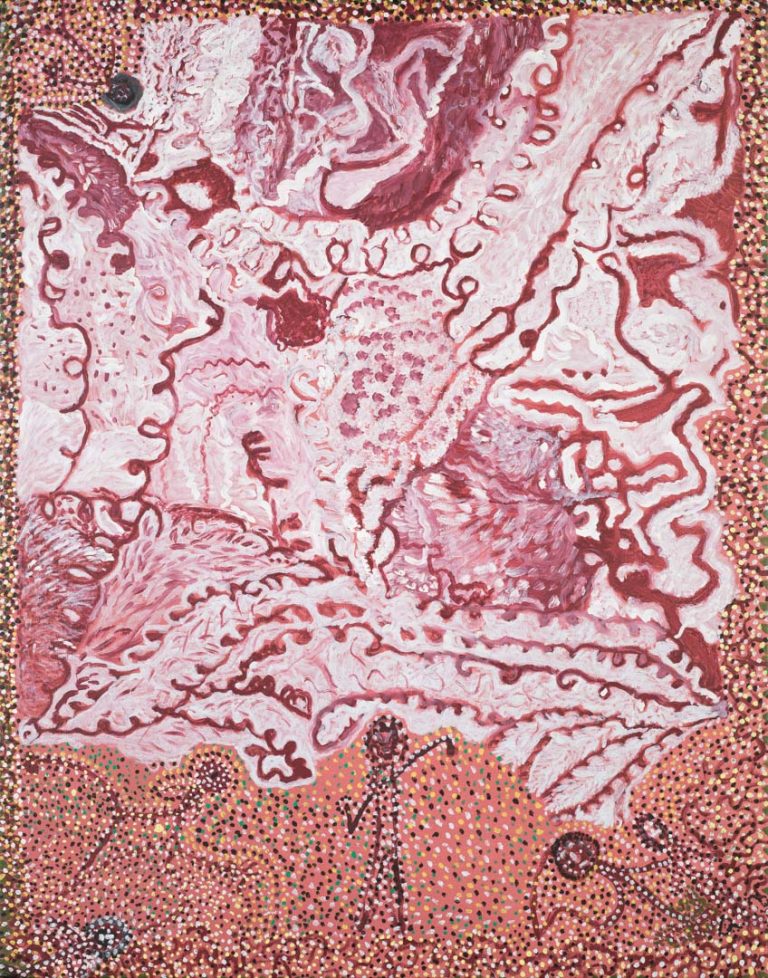We acknowledge the Traditional Owners of the land on which the Queensland Art Gallery | Gallery of Modern Art stands and recognise the creative contribution First Australians make to the art and culture of this country.

Mavis Ngallametta / Kugu-Uwanh people, Putch clan / Australia 1944–2019 / Collecting Pip Morp (white clay) at Ikalath 2009 / Synthetic polymer paint on linen / 113 x 88cm / Gift of the artist through the Queensland Art Gallery | Gallery of Modern Art Foundation 2015. Donated through the Australian Government’s Cultural Gifts Program / Collection: Queensland Art Gallery | Gallery of Modern Art / © The Estate of Mavis Ngallametta
Mavis NGALLAMETTACollecting Pip Morp (white clay) at Ikalath 2009
Not Currently on Display
I always get Edgar, my adopted son, to take me to Ikalath to collect the pip morp (white clay) for body painting for ceremonies, and now I get it for my painting too. It is part of Edgar’s country and it is beautiful. See those people in the painting? That is Edgar and me.1
Ikalath, north-east of Aurukun on the coast of west Cape York Peninsula, is a place where red-dirt cliffs emerge from sandy beaches. Along the bottom of the cliffs, a thick band of white clay is found where the mineral-rich red dirt and white clay meet a pink vein. This area has long been an important site of sacred white ochre for the Wik people. As a Kugu woman, this was not Mavis Ngallametta’s traditional place, a fact she always acknowledged. As a young woman, however, she adopted a son, Edgar, who has blood ties to this site, and, by association, she inherited a relationship with this place. This adoptive relationship did not amount to open access to this site though, so Mavis always sought permission from her son to visit Ikalath and to collect the white clay for her paintings.
Endnotes:
1. Mavis Ngallametta, quoted in QAGOMA Research Library Collection Artist File, 2015.
Mavis Ngallametta was born in 1944 into the Marbunt family of the Kugu people on their traditional country, near the Kendall River in west Cape York Peninsula. An elder of the Putch clan and a cultural leader of the Wik and Kugu people of Aurukun, Mavis is remembered for her rich legacy to her community and to art and culture nationally. Mavis embarked on her journey to become a painter relatively late in life — she did not pick up a paintbrush until 2008, at the age of 64.
Mavis lived a traditional life in the bush until she was around five, when her family was moved to the Presbyterian Mission at Aurukun. She maintained connections with family members and elders despite this upheaval, and, in time, learnt to weave dilly bags and fruit bowls made from cabbage palm and pandanus. As a result, she was first recognised for her weaving using traditional materials, which later expanded to include recycled driftnets and marine debris.
In 2008, Ngallametta began making small paintings depicting important cultural sites, and from 2010, her works grew in scale. Mavis tended to depict sites of personal significance in her paintings. Recurring subjects include Ikalath, where she collected white clay; her traditional country of Kendall River; Wutan, a camping site belonging to her adopted son Edgar; and various pamp, or swamps, dotted around Aurukun.
Discussion Questions
1. Discuss the use of colour, line, texture and pattern in Collecting Pip Morp (white clay) at Ikalath. How has Mavis Ngallametta used these elements to express the physical characteristics of Ikalath?
2. How has the artist communicated her personal and cultural relationship with this place?
Classroom Activities
The bands of colour seen in the cliffs at Ikalath are an important part of the aesthetic of Wik art. Research works by other Aurukun artists — Arthur Koo-ekka Pambegan Jr, Joe Ngallametta and Craig Koomeeta — and consider the principles of balance, unity and contrast.